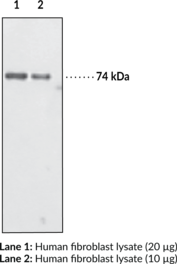Description
Immunoglobulin G (IgG) is a member of the immunoglobulin superfamily of glycoproteins that plays a central role in the adaptive immune response.{28520} It is produced by B cells and later secreted by plasma cells and is the most abundant circulating antibody in human and mouse serum.{28520,55170,55174} IgG consists of two heavy chains of approximately 50 kDa each and two light chains of approximately 25 kDa each.{28520} The heavy chains are linked together by disulfide bonds to form an Fc region and also combine with the light chains to form the Fab region, which mediate receptor and antigen binding, respectively.{55171} IgG exists as four isotypes in mice: IgG1, IgG2b, IgG3, and, in a strain-specific manner, IgG2a or IgG2c.{55172,53858} IgG3 production is driven by bacterial- or viral-associated antigens, including HIV-1 and Staphylococcus antigens, and occurs early in the immune response following IgM class-switching.{55170,52653} IgG3 binds to and neutralizes pathogens, as well as activates complement and opsonizes bacteria, leading to complement-dependent cytotoxicity (CDC) and antibody-dependent cell cytotoxicity (ADCC), respectively. Serum IgG3 levels are increased in patients with primary biliary cirrhosis, Sjögren’s syndrome, systemic sclerosis, or systemic lupus erythematosus (SLE).{52654} Cayman’s IgG3 (mouse) Rabbit Monoclonal Antibody can be used for ELISA and Western blot (WB) applications. The antibody recognizes the Fab region of IgG3 from mouse samples.
Synonyms: Immunoglobulin G3
Immunogen: Mouse IgG3
Formulation: 100 µg of protein A-purified monoclonal antibody
Isotype: IgG
Applications: WB, ELISA
Origin:
Stability: 365 days
Application|ELISA||Application|Western Blot||Product Type|Antibodies|Monoclonal Antibodies||Research Area|Cardiovascular System|Blood|Serum Proteins||Research Area|Immunology & Inflammation|Adaptive Immunity||Research Area|Immunology & Inflammation|Autoimmunity|Lupus||Research Area|Immunology & Inflammation|Innate Immunity||Research Area|Infectious Disease|Bacterial Diseases||Research Area|Infectious Disease|Viral Diseases|HIV & AIDS



